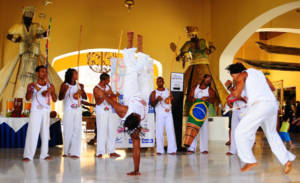“Since Rio de Janeiro has a very mild and pleasant climate during most of the year, the best time to visit is the one that meets your travel expectations. So if you want to see the city in its daily flow, connecting with people in a milder climate, the months of April to November are great.
For those who like beaches, heat and action, the months of December to February are the liveliest. Many parties, tourists and events take place, including but not limited to the fireworks on New Year’s Eve and the festivities leading up to and during Carnival.”
“The classic sightseeing spots in Rio are mandatory for all – including locals. As a tour guide, taking visitors to the top of Corcovado Mountain, where the statue of Christ the Redeemer stands, I always look at my city with renewed eyes for its natural beauty. The same applies to visiting the Pão-de-Açúcar, or Sugarloaf Mountain. These are attractions that do justice to the beauty of the city, offering visitors a privileged panorama of everything that can be enjoyed beyond the landscape.
A guided tour is worth it since, from the top of both attractions, the guide will present other charms and attractions to the visitor who seeks a broad view of the beauties of Rio de Janeiro. It is worth saying that Christ the Redeemer and Sugarloaf Mountain are just the two most popular examples, Rio enjoys countless possibilities, including for local residents who spend their lives exploring a dynamic that is continually renewed in the cultural sphere and that it is vast in its natural range.”
“Right in the heart of the Marvelous City is the Tijuca Forest, one of the largest urban forests in the world. At about 3,953 hectares in size, the forest is a fragment of the Atlantic Rainforest, and contains several trails and gems to discover. Throughout the park, you will observe many species of trees, some of which are rare and endangered, and a diversity of wildlife such as birds, monkeys, snakes, coatis and anteaters.
Travelers love exploring the various trails throughout the Forest. This, mixed with the huge water network, with waterfalls, allows for contemplating nature as well as to cool off, as some of the waterfalls are open for visitors to bathe in. Due to the large extension of the forest, some of these waterfalls are only accessible through trails, while others are easily reached by vehicles.
Besides its natural beauty, the National Park is known for its history – part of the park is actually reforested, after successive colonial occupations of coffee farms and logging, which almost led to the extinction of countless species of the original forest. Today we see ipê trees, embaúbas, quaresmeiras, bromeliads, amongst hundreds of other species coexisting with exotic species implemented in the country in the 18th century. A true natural and historic gem quite literally in the middle of the city.”
“With a diverse population and influences from around the world, the city of Rio de Janeiro offers cultural attractions for all tastes and budgets. Much of the population of Rio de Janeiro is of African descent and incorporates in the local custom, African, European and indigenous heritages that translate into local cariocas’ gastronomy and habits. We recommend experiencing the bar scene, in order to get to know locals, and enjoy the city’s infamous cold beer and bar snacks. Another way to experience the local culture is to visit the open air markets and street food stalls. In the famous snack bars you can enjoy a refreshing açaí after an invigorating bike ride on the Aterro do Flamengo. Or eat a traditional feijoada on a Sunday, to the sound of the drums coming from local samba school. Also take the opportunity to eat a codfish cake in a traditional Portuguese bar, or a chicken coxinha with “”the house”” hot sauce. “

